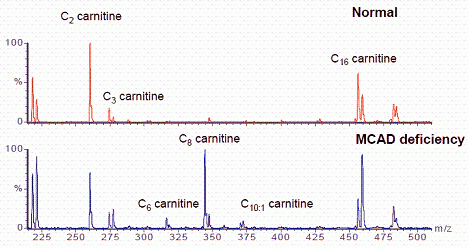Screening of newbornsEvery newborn in
Belgium is screened for a number of inhertited disorders among which
some metabolic disorders. Luckily the tests now also include MCAD
deficiency.
The screening is done by taking a bloodsample in the first week after birth. With a small needle some blood is taken from the top of the hand and the drops are collected on a special card, called a Guthrie card. The dried up blood spots are examined in a machine called a tandem mass spectrometer. With this machine can be searched for specific metabolites (rest products of biochemical processes) and this can indicate that the newborn has a specific disorder. In case of MCAD deficiency the blood of the newborn will contain high amounts of octanoylcarnitines. Octanoylcarnitine is an acylcarnitine with 8 carbons (see also the chapter about fat metabolism for more information about this). Also the level of acyl-carnitines with 6 and 10 carbons (C6 and C10) will be slightly elevated. The following image compares the normal blood image (on top) and the typical image of a patient with MCAD deficiency (below):  It is however
possible that some patients with MCAD deficiency are missed in the
newborn screening. Some patients with MCAD deficiency don't always have
abnormal acylcarnitine levels, especially if they are well fed from
directly after birth.
It is also possible that in newborn screening also carriers of MCAD deficiency are detected (see also the page on inheritance) because they too can have abnormal acylcarnitine levels. Further tests are always necessary. Once the baby is suspected to have MCAD deficiency, there are some other tests that can be done to support the diagnosis. It is for example possible to measure the enzymatic activity of the MCAD enzyme. Read further about measuring enzymatic activity >
|
||||
|
|
This page was last modified on 6 March 2011 | |||